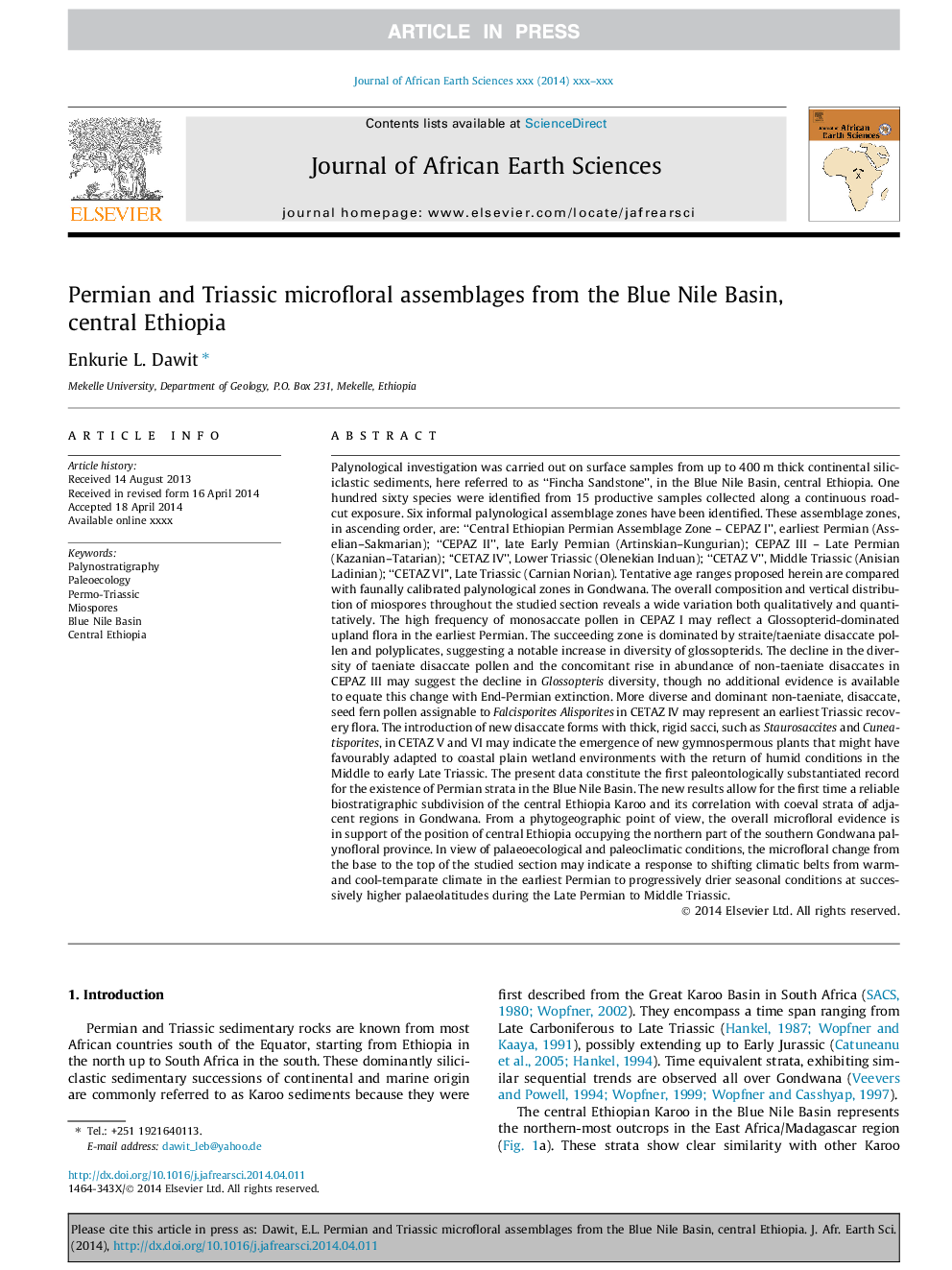| کد مقاله | کد نشریه | سال انتشار | مقاله انگلیسی | نسخه تمام متن |
|---|---|---|---|---|
| 6443853 | 1356467 | 2014 | 19 صفحه PDF | دانلود رایگان |
عنوان انگلیسی مقاله ISI
Permian and Triassic microfloral assemblages from the Blue Nile Basin, central Ethiopia
ترجمه فارسی عنوان
مجسمه های میکرو فلورال پرمین و تریاس از حوضه آبی نیل، مرکزی اتیوپی
دانلود مقاله + سفارش ترجمه
دانلود مقاله ISI انگلیسی
رایگان برای ایرانیان
کلمات کلیدی
پالینواستراتیگرافی، پالئواکولوژی، پرمو تریاس، میوسپورها، حوضه آبی نیل، اتیوپی مرکزی،
موضوعات مرتبط
مهندسی و علوم پایه
علوم زمین و سیارات
زمین شناسی
چکیده انگلیسی
Palynological investigation was carried out on surface samples from up to 400Â m thick continental siliciclastic sediments, here referred to as “Fincha Sandstone”, in the Blue Nile Basin, central Ethiopia. One hundred sixty species were identified from 15 productive samples collected along a continuous road-cut exposure. Six informal palynological assemblage zones have been identified. These assemblage zones, in ascending order, are: “Central Ethiopian Permian Assemblage Zone - CEPAZ I”, earliest Permian (Asselian-Sakmarian); “CEPAZ II”, late Early Permian (Artinskian-Kungurian); CEPAZ III - Late Permian (Kazanian-Tatarian); “CETAZ IV”, Lower Triassic (Olenekian Induan); “CETAZ V”, Middle Triassic (Anisian Ladinian); “CETAZ VI”, Late Triassic (Carnian Norian). Tentative age ranges proposed herein are compared with faunally calibrated palynological zones in Gondwana. The overall composition and vertical distribution of miospores throughout the studied section reveals a wide variation both qualitatively and quantitatively. The high frequency of monosaccate pollen in CEPAZ I may reflect a Glossopterid-dominated upland flora in the earliest Permian. The succeeding zone is dominated by straite/taeniate disaccate pollen and polyplicates, suggesting a notable increase in diversity of glossopterids. The decline in the diversity of taeniate disaccate pollen and the concomitant rise in abundance of non-taeniate disaccates in CEPAZ III may suggest the decline in Glossopteris diversity, though no additional evidence is available to equate this change with End-Permian extinction. More diverse and dominant non-taeniate, disaccate, seed fern pollen assignable to Falcisporites Alisporites in CETAZ IV may represent an earliest Triassic recovery flora. The introduction of new disaccate forms with thick, rigid sacci, such as Staurosaccites and Cuneatisporites, in CETAZ V and VI may indicate the emergence of new gymnospermous plants that might have favourably adapted to coastal plain wetland environments with the return of humid conditions in the Middle to early Late Triassic. The present data constitute the first paleontologically substantiated record for the existence of Permian strata in the Blue Nile Basin. The new results allow for the first time a reliable biostratigraphic subdivision of the central Ethiopia Karoo and its correlation with coeval strata of adjacent regions in Gondwana. From a phytogeographic point of view, the overall microfloral evidence is in support of the position of central Ethiopia occupying the northern part of the southern Gondwana palynofloral province. In view of palaeoecological and paleoclimatic conditions, the microfloral change from the base to the top of the studied section may indicate a response to shifting climatic belts from warm- and cool-temparate climate in the earliest Permian to progressively drier seasonal conditions at successively higher palaeolatitudes during the Late Permian to Middle Triassic.
ناشر
Database: Elsevier - ScienceDirect (ساینس دایرکت)
Journal: Journal of African Earth Sciences - Volume 99, Part 2, November 2014, Pages 408-426
Journal: Journal of African Earth Sciences - Volume 99, Part 2, November 2014, Pages 408-426
نویسندگان
Enkurie L. Dawit,
